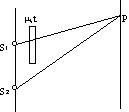Displacement of Fringes
When a film of thickness’t’ and refractive index 'm' is introduced in the path of one of the sources, then fringe shift occurs as the optical path difference changes.
Optical path difference at
P = S2P - [S1P+ µt - t] = S2P - S1P - (µ - 1)t = y.d/D - (µ - 1)
Illustration:
Monochromatic light of wavelength of 600 nm is used in a YDSE. One of the slits is covered by a transparent sheet of thickness 1.8 x 10-5 m made of a material of refractive index 1.6. How many fringes will shift due to the introduction of the sheet?
Solution:
As derived earlier, the total fringe shift = w/λ (µ-1)t .
As each fringe width = w,
The number of fringes that will shift = total fringe shift/fring width
(w/λ(µ-1)t)/w = (µ-1)t/λ = (1.6-1) x 1.8 x 10-5m / 600 x 10-9 = 18
Illustration:
In the YDSE conducted with white light (4000Å-7000Å), consider two points P1 and P2 on the screen at y1=0.2mm and y2=1.6mm, respectively. Determine the wavelengths which form maxima at these points.
Solution:
The optical path difference at P1 is
p1 =dy1/d = ( 10/4000) (0.2) = 5 x 10-4mm = 5000Å
In the visible range 4000 - 7000Å
n1 = 5000/4000 = 1.25 and n2 = 5000/7000 = 0.714
The only integer between 0.714 and 1.25 is 1
∴ The wavelength which forms maxima at P is l = 5000Å
For the point P2,
p2 = dy2/D = ( 10/4000) (1.6) = 4 x 10-3mm = 40000Å
Here n1 = 40000/4000 = 10 and n2 = 40000/7000 = 5.71
The integers between 5.71 and 10 are 6, 7, 8, 9 and 10
∴The wavelengths which form maxima at P2 are
λ1 = 4000 Å for n = 10
λ2 = 4444 Å for n = 9
λ3 = 5000 Å for n = 8
λ4 = 5714 Å for n = 7
λ5 = 6666 Å for n = 6
View courses by askIITians


Design classes One-on-One in your own way with Top IITians/Medical Professionals
Click Here Know More

Complete Self Study Package designed by Industry Leading Experts
Click Here Know More

Live 1-1 coding classes to unleash the Creator in your Child
Click Here Know More

a Complete All-in-One Study package Fully Loaded inside a Tablet!
Click Here Know MoreAsk a Doubt
Get your questions answered by the expert for free

